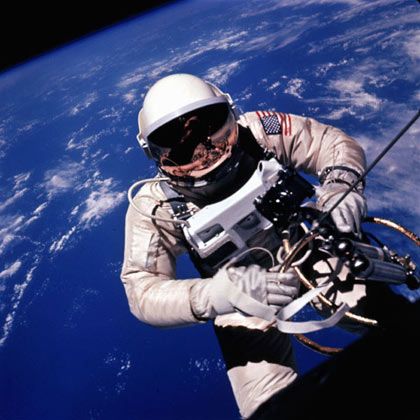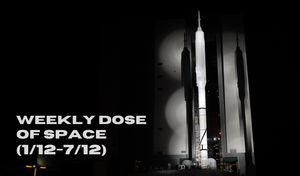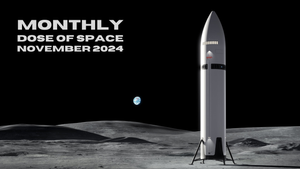
Weekly Dose of Space (28/7-3/8)
Welcome back to Weekly Dose of Space! This week had six launches occur, with half being performed by Falcon 9. News this week had two International Space Station-related crew announcements, and SpaceX unveil its newest iteration of the Raptor engine. As always, we'll also look ahead to what the worldwide launch schedule might look like next week.
SpaceX
This week at Starbase began in the early hours of the 28th when Ship 30 was moved into the 'rocket garden' at the production site, after it returned from the Massey's test site the day before.
Late on the 30th, the sixth module of the second launch tower was rolled out to the launch site, and work on preparing to lift the fifth and sixth modules began on the 31st.
After waiting a few days, the fifth module of the second launch tower was lifted and secured to the tower on August 1st. August 2nd saw the sixth module beginning preparations to lift. The following day, August 3rd, the sixth module was lifted onto the second launch tower, work to secure it started shortly after the lift.
Launches This Week
July 28th - Falcon 9 with Starlink Group 10-4
Falcon 9 lifted off from Space Launch Complex 40 carrying twenty-three Starlink satellites to low Earth orbit. The booster for this mission was B1077 on its fourteenth flight and landing successfully on the drone ship 'A Shortfall of Gravitas' downrange.

July 28th - Falcon 9 with Starlink Group 9-4
Twenty-one Starlink satellites were delivered to low Earth orbit after a launch atop of Falcon 9 from Space Launch Complex 4E. The booster for this mission was B1071 making its seventeenth launch and landing, with it landing downrange on the drone ship 'Of Couse I Still Love You' for this mission.

July 30th - Atlas V for USSF-51
United Launch Alliance launched an Atlas V from Space Launch Complex 41 for the USSF-51 mission. The payload onboard is unknown to the public due to its classified military nature.
Here’s one from the Lightning Tower. #AtlasV #USSF51 pic.twitter.com/SGDBLtVV69
— Tory Bruno (@torybruno) August 2, 2024
Atlas V lifting off from Space Launch Complex 40 for USSF-51, via Tory Bruno on X.
August 1st - Long March 3B/E with WHG-02
A Long March 3B/E lifted off from the Xichang Satellite Launch Center carrying a new communications satellite to a geosynchronous transfer orbit. The satellite was the second ‘Internet high-orbit satellite’ (Weixing Hulianwang Gaogui, WHG) spacecraft.

August 2nd - Falcon 9 with Starlink Group 10-6
SpaceX launched another twenty-three Starlink satellites to low Earth orbit from Launch Complex 39A, in Florida. The booster for this mission was B1078 on its twelfth flight, with it landing downrange on the drone ship 'A Shortfall of Gravitas' downrange.

August 2nd - Electron for 'Owl for One, One for Owl'
Rocket Lab launched an Electron from Launch Complex 1B, on the Māhia Peninsula, carrying a synthetic aperture radar satellite to a sun-synchronous orbit for Synspective.
Turn it up. pic.twitter.com/BEcw94jWdv
— Peter Beck (@Peter_J_Beck) August 2, 2024
Electron lifting off from Launch Complex 1B for 'Owl for One, One for Owl', via Peter Beck on X.
In Other Space News
SpaceX unveils first Raptor 3 engine

In a series of posts on X, formerly Twitter, SpaceX and Elon Musk, SpaceX's Chief Executive Officer, revealed the details about the newest version of the company's Raptor engine, called Raptor 3.
The posts from SpaceX state that the thrust of a Raptor 3 sea-level variant is 280 tons, with a specific impulse of 350 seconds. Raptor 3's mass has also seen a small decrease from Raptor 2, with Raptor 3 weighing 1,525 kilograms and Raptor weighing 1,630 kilograms. Compared to Raptor 2, Raptor 3 has increased the engines thrust by 50 tons and the specific impulse by 3 seconds.
Raptor 3 has also simplified a significant amount of the externals of the engine. SpaceX hopes the Raptor 3 will enable rapid reuse of its fully reusable Starship-Super Heavy launch vehicle, when it begins to fly Raptor 3 engines.
Indian astronaut to fly to the ISS

The Indian Space Research Organisation announced on August 2nd that Shubhanshu Shukla will fly to the International Space Station as the pilot for the Axiom-4 mission. Shubhanshu Shukla and his backup, Balakrishnan Nair, will train for the mission in the United States, beginning in early August. In the announcement, the agency said the following:
"Towards the goal of mounting a joint ISRO-NASA effort, the Human Space Flight Centre (HSFC) of ISRO has entered into a Space Flight Agreement (SFA) with NASA-identified service provider M/s Axiom Space Inc.,USA for its upcoming Axiom-4 mission to the ISS. A National Mission Assignment Board has recommended two Gaganyatris as prime and backup Mission Pilot for this mission. These are Group Captain Shubhanshu Shukla (Prime) and Group Captain Prasanth Balakrishnan Nair (Backup). The assigned crewmembers will be finally approved to fly to the International Space Station by the Multilateral Crew Operations Panel (MCOP)."
The Axiom-4 mission is expected to carry four astronauts, Peggy Whitson (United States), Shubhanshu Shukla (India), Sławosz Uznański (Poland), and Tibor Kapu (Hungary). The mission is expected to launch in October 2024.
India also calls its astronauts Gaganyatri.
NASA reveals Crew-10 astronauts

On August 1st, NASA announced the astronauts for its Crew-10 mission to the International Space Station. The crew are Commander Anne McClain (NASA), Pilot Nichole Ayers (NASA), Mission Specialist Takuya Onishi (JAXA), and Mission Specialist Kirill Peskov (Roscosmos).
The four Crew-10 astronauts will spend approximately six months onboard the International Space Station, conducting science and maintaining the station.
Launch is currently expected no earlier than February of 2025 onboard of SpaceX's Crew Dragon capsule, being sent into orbit by Falcon 9 from Florida. The Crew Dragon capsule for the Crew-10 mission will also be a new spacecraft, and the crew will name it once on orbit.
What to Expect Next Week
Starbase
As is usual now, SpaceX is still awaiting regulatory approvals for changes in its flight plan for the fifth test flight. Regulatory approval for this flight is needed due to a potential landing of Booster 12 back at the launch site, on the launch towers 'chopsticks'.
With static fires performed by both flight vehicles, Booster 12 and Ship 30, the final major hardware milestone is still expected to be a wet dress rehearsal for both vehicles on the launch pad.
August 4th - Falcon 9 with Starlink Group 11-1
SpaceX is expected to launch a batch of Starlink satellites to low Earth orbit atop of Falcon 9 from Space Launch Complex 4E, in California. The booster for this mission is also unknown but it will land downrange on the drone ship 'Of Course I Still Love You'.
August 4th - Falcon 9 with Cygnus NG-21
SpaceX is targeting August 4th to launch the twentieth Cygnus resupply mission to the International Space Station from Space Launch Complex 40, in Florida, atop of Falcon 9. Cygnus is expected to bring science experiments, equipment, and consumables to the crew aboard the station.
August 6th - Long March 6A with a to-be-announced payload
A Long March 6A is expected to launch from the Taiyuan Satellite Launch Center carrying another currently unknown payload.
August 7th - Falcon 9 with Starlink Group 8-3
Another Falcon 9 is expected to launch yet another batch of Starlink Satellites from Space Launch Complex 40, in Florida. The booster for this mission is unknown but it is expected to land downrange on a drone ship.




